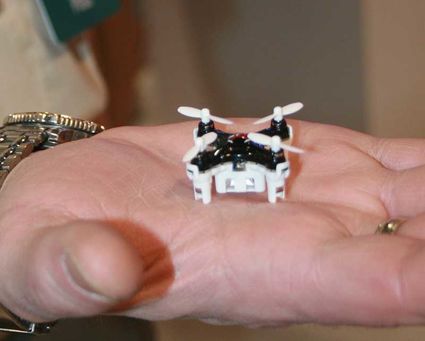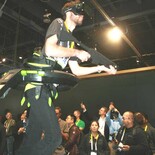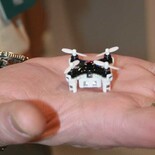Adventure to the Consumer Electronics Show yielded few Martian technologies
Sky Watch keeping an eye on the horizon
As an electronics engineer, I've always wanted to visit the fabled International Consumer Electronics Show (CES) in Las Vegas. However, since I was working in medical electronics, my company wasn't about to spend four-figures to send me there. Today I find myself a journalist and can therefore go for free! My mission: Identify consumer technologies (small bucks) that the aerospace industry (big bucks) may be overlooking as we plan to send people to Mars. Here's what we found.
CES has become a behemoth! Over 170,000 people poured though 2.5 million square feet of exhibits stretching from the Westgate Hotel (the old Las Vegas Hilton) south to the Mandalay Bay resort. Parties went on all over town all night long. We were packed onto the monorail as tight as sardines. If you dared to drive, you had to pay $40 to park when you stopped! Many venues required special insider passes that allowed you to stand in line for at least an hour to see the latest and greatest widgets. The staff and civic officials did an amazing job of managing this monstrosity.
Nevertheless, the trip was overall enjoyable and eye-opening. There are indeed a number of technical advances that will improve our lifestyles. (There were also modern "snake oil" salesmen claiming that their gadget cured all sorts of maladies. I hope our FDA enforcement officers were scouring this target-rich environment!)
General purpose household robots are still a promising technology (with an emphasis on 'promise'). The press enjoyed an impressive demonstration--until I spotted the computer operator in the corner sending it commands. ("Pay no attention to that man behind the curtain!") That's why sending humans to Mars still makes good sense.
The Internet of Things (IoT) is something we'll be hearing a great deal more about very soon. Our electronic gadgets are going to start talking to each other--and the Internet--as a matter of course. Smart phones, smart homes, smart cars, smart TVs, and wearable devices of all kinds will become more seamlessly integrated.
The front of our refrigerators will become less a nexus for family photos and more of a command and control center for family activities. We'll be able to see what's in the fridge while we're in the supermarket, or check to see that we closed the garage door from the office. (Personally, I foresee a lot of hazards and potential for abuse with that much integration, so I'll be hanging back on that technology.)
Virtual reality (VR) is continuing to improve. Headsets are getting lighter, definition and refresh rates are improving, and software applications are steadily expanding. Along with augmented reality (AR), these capabilities will be essential for our Martian astronauts to control our high-tech machines on Mars.
There is an increasing belief that humanity's first voyage to Mars should be an orbital mission, avoiding the massive expense and complexity of landing on the surface and taking off again. Our ability to control our rovers and aircraft below in real time using VR would be a key element of a robust mission.
Drones are all the rage! Particularly impressive was one that was smaller and lighter than a Rice-Crispy Bar, and priced at only $40! Curiously, we couldn't find anyone who'd considered what a drone would look like that could fly in the super-thin atmosphere of Mars (but, perhaps we stimulated some thinking).
3D-printing is maturing rapidly. The ability to make almost anything imaginable is a highly leveragable technology when so far from home. This technology is already being tested aboard the International Space Station.
We saw complex parts made not just of polymers, but also Kevlar, fiberglass, carbon fiber, and even titanium. 3D-printing can be used to make parts that are far too complex for even the most advanced machining techniques. The size of the parts is also getting much larger. In principle, there's no limit to how large these machines can be.
And prices are coming down. Small 3D printers can now be had for $300, putting them within reach of high school students and small entrepreneurs.
I finally had a chance to check out smart glasses, where an image is projected in front of you through a small piece of glass at the edge of your eyeglasses. As with most people my age, I'm rather far-sighted. That means I can't see up close without (quite strong) reading glasses. I've always wondered how I could possibly use a device requiring me to focus on something only an inch from my eye. I was astounded to find that I perceived the image as if it really was six inches away! Truly amazing.
There are many social issues involved with the wearing of these type of glasses, especially since many also incorporate cameras. However, I'm sure that they will soon become standard accessories for many professionals, such as pilots and astronauts.
On the personal-audio side, the Bone Fone is back. In case you missed it: Back in the late 1970s, the Bone Fone introduced the idea of conducting sound waves through the collar bones and up into ears. It was rather large and hung around your neck. It was only a qualified success because of its bulky electronics and large batteries, and because a great deal of sound escaped to the outside environment, annoying others.
The idea resurfaced three years ago with a vastly smaller unit that sits just in front of the ears (rather than down on the collar bones). Like the Bone Fone (and unlike earbuds or headphones), it leaves the ear canals open to receive sound from the outside world. I didn't find the sound quality suitable for music, but it was fine for voice communications, talk radio, or recorded books. I'll be looking into this innovation.

Lauren Hollen
While too small for a camera or microphone (so far), this little drone could be hovering a few feet overhead and you wouldn't even notice. And yes, we really did see it fly! Photo by Lauren Hollen
Summation: While there are some fun things coming down the pike for consumers, NASA and the other fine people in aerospace R&D aren't overlooking much. That's certainly good news since that's what we pay them for. Still, it was a fine excuse to spend a week in Las Vegas doing something I've always wanted to do--once! (I never have been into big crowds, and this was about as big as it gets!)
Almanac
After spending plenty of time in the eastern morning sky, the bright planets are finally spreading out. As February progresses, Jupiter will rise as the sun sets, followed by Mars around midnight. Saturn, Venus, and now Mercury, are still morning planets.
Mars is getting brighter as we head for a close approach in May. It's now easier to discern its ruddy color. However, it's still too small to make out any surface features.
Saturn's rings are still tilted near their maximum, affording a wonderful telescopic view.
Sunrise/Sunset: 6:53 am/5:22 pm (February 1st)








